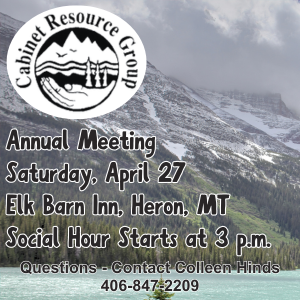Virtual series explores 'What Unites Us'
January 20, 2022
Sanders County Democrats hosted the second installment of their virtual cinema series, “What Unites Us” this month. January’s program focused on federal funding and how it fuels Sanders County. The hour-long event saw around 30 attendees, including community members from Mineral and Lincoln counties, as well as several guest speakers.
“The intention of this six-month virtual video series is to get past the barriers of division in that we hear so much of and the partisanship in our county particularly, and focus on the topics that unite and support us here in our county,” said Sanders County Democrats Chairperson Mindy Ferrell.
More than 165 Sanders County businesses and entities were awarded funding from the 2020 CARES Act. In the state legislature, the bi-annual budget was over $16 billion, and of that, over $9.5 billion is sourced from federal money.
The event began with a short video called, “The I-35W Minneapolis Bridge Collapse.” Debra Achatz, Master of Ceremonies of the evening’s program, said in response to the video, “that’s certainly something we never want to see happen here.” Achatz says there are 377 bridges in the state of Montana that need to be repaired.
“Thanks to the Infrastructure, Investments and Jobs ACT that was just passed, Montana has been allocated billions of dollars over the next 10 years to fix some of these bridges and our highways. It’s going to address cyber borders, fire security, water delivery systems and a lot more.”
Achatz says for every dollar sent to the federal government, the state of Montana gets $1.38 back. “That’s a pretty good return on an investment,” she said. “Sanders County was infused with approximately $5.6 million. That money went to businesses, schools and nonprofits.”
Former state senator Jim Elliott of Trout Creek, who had recently taken on the position of chair for the Trout Creek landfill, said the position instilled a sense of community, while at the same time, it helped him recognize the need for infrastructure, as the Trout Creek landfill was on the verge of closing. “Montana relies an awful lot on federal dollars,” Elliott said. “The money that is largely spent in the area of healthcare and highway construction.”
Elliott gave some numbers as to how much federal funding comes into Montana on an annual and bi-annual basis. The Department of Health and Human Services takes in $2.22 billion from federal funding on an annual basis. The Department of Transportation (DOT) takes in $1.55 billion on a bi-annual basis. “Fish and game rely on 25 percent of its budget on federal money,” Elliot said.

Carla Neiman, Chief Financial Officer for Clark Fork Valley Hospital (CFVH), spoke on how federal funding is connected to the hospital. “It’s hard for me to even imagine what healthcare would look like in Sanders County if it weren’t for federal funding,” Neiman said. “Our local hospital is highly dependent on federal funding and has benefited greatly from federal programs designed to enhance rural healthcare.”
Two federally funded programs relied heavily on in Sanders County are Medicare, which provides healthcare for the disabled and senior citizens age 65 years and older; and Medicaid, which provides healthcare for low-income populations. Neiman says, traditionally in Montana, the low-income population consists of pregnant women, children, elderly and the disabled. Medicaid was not available for able bodied adults until Medicaid Expansion was approved in the state.
“Medicaid is a state managed program, but is largely funded by the federal government,” Neiman said. In 2020, 76 percent of CFVH’s $26 million net patient service revenue was paid for by the Medicare and Medicaid programs. Neiman says the majority of the county’s nursing home residents have their nursing home care paid by Medicaid. The hospital has also received substantial federal funding to assist with the response to COVID-19. “There’s no doubt Medicaid Expansion has helped our hospital from the standpoint that it has reduced the number of uninsured in Sanders County,” Neiman said.
In 2015, five percent of the hospital’s net patient revenue came from those who were uninsured. In 2019, that was reduced to one percent. “When I think of the benefits of Medicaid Expansion, I tend to be more focused on our residents and patients,” Neiman said.
As of December 2021, there were 1,458 Sanders County residents enrolled in Medicaid Expansion, which is 12.4% of the county’s population. Overall, Medicaid enrollment in Sanders County is close to 2,000 – 16% of the county’s population. Neiman says most of the people enrolled in Medicaid would be uninsured if it weren’t the assistance of the federal funding for these programs.
Gayle Seratt, Director of Sanders County Coalition for Families, says the nonprofit is reliant on funding, both state and federal, for the various services they offer. With an overall annual budget of around $866,000, Seratt says they bring in funding from seven different grants, three of which come from the Department of Justice, totaling just over $600,000.
“I would say the majority of this money stays in Sanders County,” Seratt said. “We employ 10 people. Additionally, we pay a sheriff’s detective’s salary which we reimburse the county for.” Seratt says part of their funding goes toward a law group out of Missoula that provides legal services to their clients.
“We serve around 200 people per year,” Seratt said. “Without funding, we would not be able to provide the level of services to those in the county.”
Ferrell says the “What Unites Us” recordings can be found by linking through the tab on the Sanders County Democrats website, http://www.sanderscountydemocrats.org.
The next installment of “What Unites Us” will feature retired Montana Supreme Court Justice Jim Nelson and will focus on Montana's Constitution. It will be available on Zoom Sunday, February 13, at 4 p.m.



Reader Comments(0)